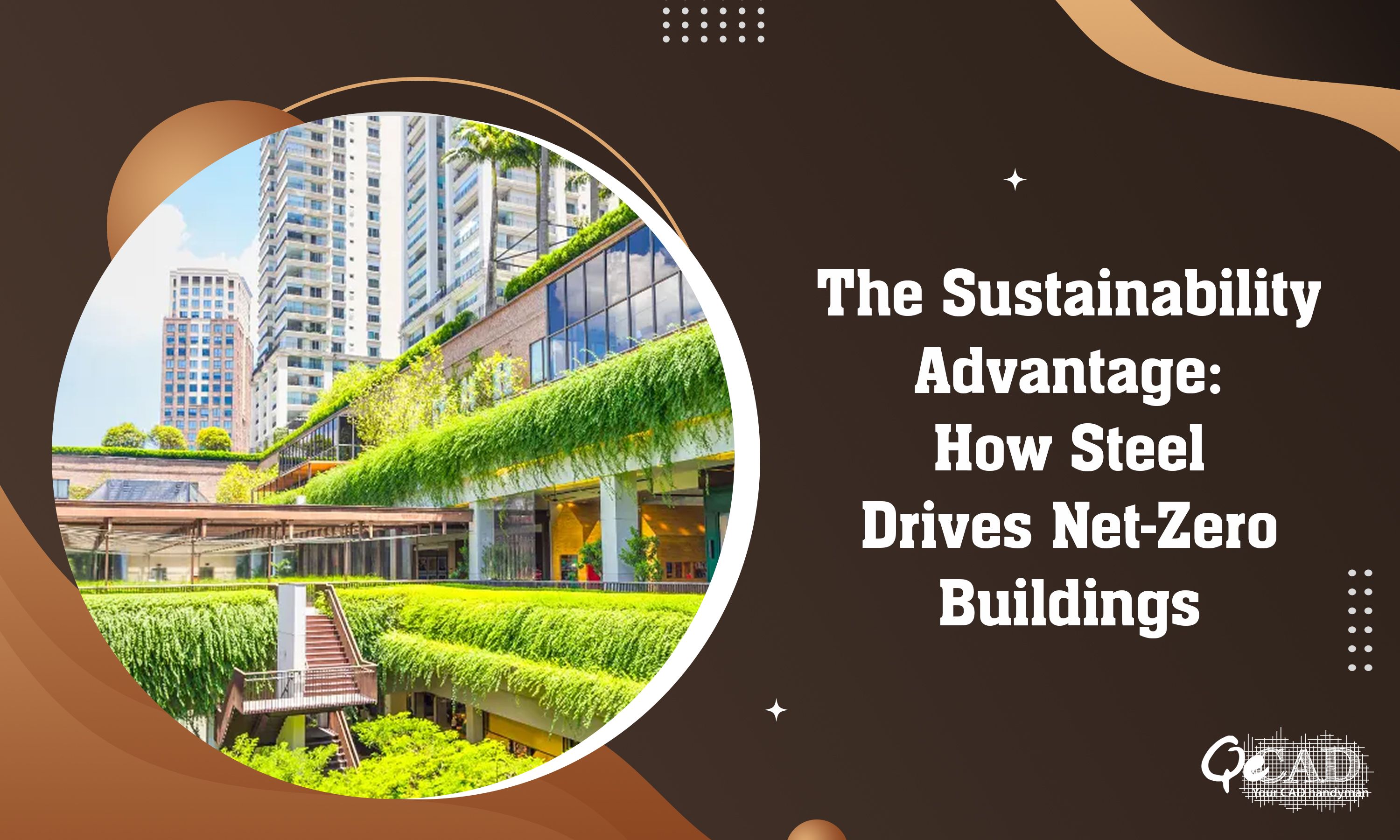
In the race against the climate change, the AEC industry plays a crucial role in transforming a sustainable future. Among the innovations revolutionizing the industry is the concept of Net-Zero Buildings which focuses on saving the energy overall thereby benefiting the environment.
Steel being a key material in the construction today is also playing an important role in Net-Zero builds due to its properties like strength, versatility and recyclability.
Let’s dig deep into how steel is contributing towards a sustainable tomorrow.
Net-Zero Buildings: A Blueprint for Carbon Neutrality
Net-zero buildings are designed to balance their energy consumption with the energy they generate, creating a sustainable and self-sufficient model. They achieve equilibrium through the energy-efficiency and renewable energy generations. These buildings do prioritize the resource optimization, minimal carbon emissions along with the long-term sustainability.
This concept aligns well with the global goals to combat the climatic change and reduce the carbon footprints thereby making it a cornerstone in sustainable construction practices.
For instance, the Bullitt Center in Seattle, USA, stands as one of the world’s most environmentally sustainable commercial buildings. It incorporates steel in its framework to support its energy-efficient systems. This includes rainwater harvesting and solar power generation thereby achieving net-zero energy and water usage.
Steel in Sustainable Construction
1. How Steel Recycling Drives the Circular Economy?
Steel is one of the most recyclable materials around the globe with a recycling rate of approximately 85-90%. This positions it as a key element of the circular economy thereby reducing the reliance on virgin materials and minimizing energy consumption during production.
Steel from the deconstructed buildings can be reused or repurposed without degrading its quality ultimately ensuring a sustainable lifecycle.
For instance, the Shard in London, one of the tallest buildings in Europe did used the recycled steel during its construction to reduce its environmental footprint. This is the best example of how steel contributes to a circular economy.
2. Why Steel’s Strength-to-Weight Ratio is a Sustainability Game-Changer
Steel’s exceptional strength-to-weight ratio allows the architects as well as the engineers to use less material without compromising on the structural integrity. This property reduces the overall carbon footprint by minimizing the resource extraction and the transportation needs while maintaining the robust construction standards.
An excellent example is the Beijing National Stadium (Bird’s Nest), where an innovative use of steel provided the required strength while minimizing the material use thereby making it an engineering marvel with sustainable credentials.
3. Prefabrication with Steel: Faster, Cleaner, and Greener
The prefabricated steel components which are designed using accurate Structural BIM Services supports faster construction timelines as well as minimize the on-site waste.
Modular steel construction aligns well with the sustainability goals by optimizing the material use and reducing the construction energy consumption thereby enabling easier disassembly and reuse.
The Brock Commons Tallwood House in Vancouver demonstrates this approach. It incorporates a hybrid of steel and wood prefabricated components thereby achieving significant time and material savings during construction.
4. Enhancing Thermal Performance with Advanced Steel Products
Innovative steel products, such as insulated steel panels and thermal break technologies enhance a building’s energy efficiency. These systems provide a superior thermal insulation, reducing energy demand for heating and cooling and ultimately contributing to a building’s net-zero status.
For example, Pixel Building in Melbourne, Australia, uses insulated steel panels in its construction to maintain the thermal efficiency while generating all its energy on-site through renewable systems.
5. How Steel Supports On-Site Energy Generation for Net-Zero Buildings?
Steel facilitates the seamless integration of renewable energy systems like solar panels as well as wind turbines, into the building designs. Its structural strength and adaptability allow for efficient placement of these systems thereby enabling energy generation that offsets the operational consumption.
The Apple Park Campus in California leverages steel to support large-scale solar installations ultimately contributing to its status as one of the most energy-efficient corporate campuses in the world.
6. Steel’s Role in Climate-Resilient and Seismic-Safe Buildings
Steel’s resilience against the seismic activity and extreme weather conditions ensures the longevity of net-zero buildings. Its durability decreases the frequency of repairs or replacements. This also helps minimize material waste and the emissions associated with it.
Japan’s Skytree Tower is an example of steel’s seismic resistance. Designed to endure earthquakes, the structure uses the advanced steel engineering to ensure the long-term durability with minimal environmental impact.
7. The Sustainability Cycle: Recycling Steel for Future Constructions
At the end of its lifecycle, the steel components can be recycled to create new products, perpetuating the material’s sustainability credentials. Unlike many materials, steel retains its core properties through multiple recycling cycles thereby ensuring continued utility in the construction sector.
To maximize these benefits, Steel Detailing Services play a centre role. They ensure precise planning and design, optimizing material usage and reducing waste, all while enhancing the efficiency of construction processes.
Projects like the World Trade Center Transportation Hub in New York use recycled steel ensuring sustainability from construction to deconstruction.
What’s Next for Steel in Sustainable Architecture?
The future of steel in sustainable construction looks promising, driven by the advancements in the material science and green technologies. Steel manufacturers are exploring low-carbon production processes, like hydrogen-based steelmaking and carbon capture technologies, to further reduce the emissions. Additionally, smart steel innovations, like sensors embedded within steel structures will enable real-time energy optimization in net-zero buildings.
In construction industry, the steel’s role as a sustainable, resilient and versatile material will solidify its place at the forefront of net-zero building innovations. By combining steel’s strengths with cutting-edge technologies and sustainable practices, we are leading the charge for a more eco-conscious and durable built environment.
Conclusion
The journey toward a sustainable future demands innovative solutions, and steel’s integration into net-zero buildings exemplifies the industry’s commitment to combating climate change. From its recyclability to its structural versatility, steel is proving to be an indispensable material in creating buildings that harmonize with nature, ensuring a legacy of sustainability for generations to come.
